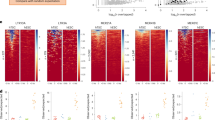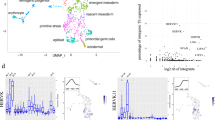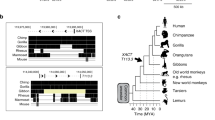Abstract
The mammalian placenta is remarkably distinct between species, suggesting a history of rapid evolutionary diversification1. To gain insight into the molecular drivers of placental evolution, we compared biochemically predicted enhancers in mouse and rat trophoblast stem cells (TSCs) and found that species-specific enhancers are highly enriched for endogenous retroviruses (ERVs) on a genome-wide level. One of these ERV families, RLTR13D5, contributes hundreds of mouse-specific histone H3 lysine 4 monomethylation (H3K4me1)- and histone H3 lysine 27 acetylation (H3K27ac)-defined enhancers that functionally bind Cdx2, Eomes and Elf5—core factors that define the TSC regulatory network. Furthermore, we show that RLTR13D5 is capable of driving gene expression in rat placental cells. Analysis in other tissues shows that species-specific ERV enhancer activity is generally restricted to hypomethylated tissues, suggesting that tissues permissive for ERV activity gain access to an otherwise silenced source of regulatory variation. Overall, our results implicate ERV enhancer co-option as a mechanism underlying the extensive evolutionary diversification of placental development.
This is a preview of subscription content, access via your institution
Access options
Subscribe to this journal
Receive 12 print issues and online access
$209.00 per year
only $17.42 per issue
Buy this article
- Purchase on Springer Link
- Instant access to full article PDF
Prices may be subject to local taxes which are calculated during checkout






Similar content being viewed by others
Accession codes
References
Mossman, H.W. Vertebrate Fetal Membranes: Comparative Ontogeny and Morphology; Evolution; Phylogenetic Significance; Basic Functions; Research Opportunities (Rutgers University Press, New Brunswick, New Jersey, 1987).
Enders, A. Reasons for diversity of placental structure. Placenta 30 (suppl. A), S15–S18 (2009).
Crespi, B. & Semeniuk, C. Parent-offspring conflict in the evolution of vertebrate reproductive mode. Am. Nat. 163, 635–653 (2004).
Haig, D. Genetic conflicts in human pregnancy. Q. Rev. Biol. 68, 495–532 (1993).
Knox, K. & Baker, J.C. Genomic evolution of the placenta using co-option and duplication and divergence. Genome Res. 18, 695–705 (2008).
Rossant, J. & Cross, J.C. Placental development: lessons from mouse mutants. Nat. Rev. Genet. 2, 538–548 (2001).
Hughes, A.L., Green, J.A., Garbayo, J.M. & Roberts, R.M. Adaptive diversification within a large family of recently duplicated, placentally expressed genes. Proc. Natl. Acad. Sci. USA 97, 3319–3323 (2000).
Hou, Z., Romero, R., Uddin, M., Than, N.G. & Wildman, D.E. Adaptive history of single copy genes highly expressed in the term human placenta. Genomics 93, 33–41 (2009).
Chuong, E.B., Tong, W. & Hoekstra, H.E. Maternal-fetal conflict: rapidly evolving proteins in the rodent placenta. Mol. Biol. Evol. 27, 1221–1225 (2010).
Carroll, S.B. Evo-devo and an expanding evolutionary synthesis: a genetic theory of morphological evolution. Cell 134, 25–36 (2008).
Roberts, R.M. & Fisher, S.J. Trophoblast stem cells. Biol. Reprod. 84, 412–421 (2011).
Beck, A.H. et al. 3′-end sequencing for expression quantification (3SEQ) from archival tumor samples. PLoS ONE 5, e8768 (2010).
Zhou, V.W., Goren, A. & Bernstein, B.E. Charting histone modifications and the functional organization of mammalian genomes. Nat. Rev. Genet. 12, 7–18 (2011).
Rugg-Gunn, P.J., Cox, B.J., Ralston, A. & Rossant, J. Distinct histone modifications in stem cell lines and tissue lineages from the early mouse embryo. Proc. Natl. Acad. Sci. USA 107, 10783–10790 (2010).
Feschotte, C. Transposable elements and the evolution of regulatory networks. Nat. Rev. Genet. 9, 397–405 (2008).
Ref Genome Sequencing Project Consortium. Genome sequence of the Brown Norway rat yields insights into mammalian evolution. Nature 428, 493–521 (2004).
Lynch, V.J., Leclerc, R.D., May, G. & Wagner, G.P. Transposon-mediated rewiring of gene regulatory networks contributed to the evolution of pregnancy in mammals. Nat. Genet. 43, 1154–1159 (2011).
Ng, R.K. et al. Epigenetic restriction of embryonic cell lineage fate by methylation of Elf5. Nat. Cell Biol. 10, 1280–1290 (2008).
Niwa, H. et al. Interaction between Oct3/4 and Cdx2 determines trophectoderm differentiation. Cell 123, 917–929 (2005).
Russ, A.P. et al. Eomesodermin is required for mouse trophoblast development and mesoderm formation. Nature 404, 95–99 (2000).
He, H.-H. et al. Nucleosome dynamics define transcriptional enhancers. Nat. Genet. 42, 343–347 (2010).
Yoon, S.-J., Wills, A.E., Chuong, E., Gupta, R. & Baker, J.C. HEB and E2A function as SMAD/FOXH1 cofactors. Genes Dev. 25, 1654–1661 (2011).
Faria, T.N. & Soares, M.J. Trophoblast cell differentiation: establishment, characterization, and modulation of a rat trophoblast cell line expressing members of the placental prolactin family. Endocrinology 129, 2895–2906 (1991).
Shen, Y. et al. A map of the cis-regulatory sequences in the mouse genome. Nature 488, 116–120 (2012).
Prudhomme, S., Bonnaud, B. & Mallet, F. Endogenous retroviruses and animal reproduction. Cytogenet. Genome Res. 110, 353–364 (2005).
Molaro, A. et al. Sperm methylation profiles reveal features of epigenetic inheritance and evolution in primates. Cell 146, 1029–1041 (2011).
Rowe, H.M. & Trono, D. Dynamic control of endogenous retroviruses during development. Virology 411, 273–287 (2011).
Cordaux, R. & Batzer, M.A. The impact of retrotransposons on human genome evolution. Nat. Rev. Genet. 10, 691–703 (2009).
Bourque, G. et al. Evolution of the mammalian transcription factor binding repertoire via transposable elements. Genome Res. 18, 1752–1762 (2008).
Feschotte, C. & Gilbert, C. Endogenous viruses: insights into viral evolution and impact on host biology. Nat. Rev. Genet. 13, 283–296 (2012).
Haig, D. Retroviruses and the placenta. Curr. Biol. 22, R609–R613 (2012).
Erlebacher, A., Price, K.A. & Glimcher, L.H. Maintenance of mouse trophoblast stem cell proliferation by TGF-β/activin. Dev. Biol. 275, 158–169 (2004).
Asanoma, K. et al. FGF4-dependent stem cells derived from rat blastocysts differentiate along the trophoblast lineage. Dev. Biol. 351, 110–119 (2011).
Li, H. & Durbin, R. Fast and accurate short read alignment with Burrows-Wheeler transform. Bioinformatics 25, 1754–1760 (2009).
Zhang, Y. et al. Model-based analysis of ChIP-Seq (MACS). Genome Biol. 9, R137 (2008).
Quinlan, A.R. & Hall, I.M. BEDTools: a flexible suite of utilities for comparing genomic features. Bioinformatics 26, 841–842 (2010).
McLean, C.Y. et al. GREAT improves functional interpretation of cis-regulatory regions. Nat. Biotechnol. 28, 495–501 (2010).
Liu, T. et al. Cistrome: an integrative platform for transcriptional regulation studies. Genome Biol. 12, R83 (2011).
Bailey, T.L. et al. MEME SUITE: tools for motif discovery and searching. Nucleic Acids Res. 37, W202–W208 (2009).
Newburger, D.E. & Bulyk, M.L. UniPROBE: an online database of protein binding microarray data on protein-DNA interactions. Nucleic Acids Res. 37, D77–D82 (2009).
Giordano, J. et al. Evolutionary history of mammalian transposons determined by genome-wide defragmentation. PLoS Comput. Biol. 3, e137 (2007).
Chinwalla, A.T. et al. Initial sequencing and comparative analysis of the mouse genome. Nature 420, 520–562 (2002).
Langmead, B., Trapnell, C., Pop, M. & Salzberg, S.L. Ultrafast and memory-efficient alignment of short DNA sequences to the human genome. Genome Biol. 10, R25 (2009).
Anders, S. & Huber, W. Differential expression analysis for sequence count data. Genome Biol. 11, R106 (2010).
Acknowledgements
The authors wish to thank G. Barsh for helpful comments, the laboratory of A. Sidow for assistance with sequencing and J. Rossant (Hospital for Sick Children) for contribution of mouse TSCs. This work was supported by the Stanford Genome Training Grant (E.B.C.; T32 HG000044), a National Science Foundation Graduate Research Fellowship (E.B.C.; 2008052909), the Stanford Bio-X program (J.C.B.) and the Burroughs Welcome Prematurity Initiative (J.C.B.; 1008847).
Author information
Authors and Affiliations
Contributions
E.B.C. and J.C.B. conceived and designed the study and wrote the manuscript. E.B.C. designed and performed RNA-seq and ChIP-seq experiments and analyzed the data. M.A.K.R. and M.J.S. provided rat samples. M.A.K.R. performed luciferase assays.
Corresponding authors
Ethics declarations
Competing interests
The authors declare no competing financial interests.
Supplementary information
Supplementary Text and Figures
Supplementary Figures 1–5 (PDF 4086 kb)
Supplementary Table 1
Putative regulatory TEs in mouse TSCs, H3K9me3 (XLS 141 kb)
Supplementary Table 2
Putative regulatory TEs in mouse TSCs, H3K27me3 (XLS 116 kb)
Supplementary Table 3
Putative regulatory TEs in mouse TSCs, H3K4me3/TSS (XLS 98 kb)
Supplementary Table 4
Putative regulatory TEs in mouse TSCs, H3K4me1/distal (XLS 145 kb)
Supplementary Table 5
Putative regulatory TEs in mouse TSCs, H3K27ac/distal (XLS 134 kb)
Supplementary Table 6
Putative regulatory TEs in mouse TSCs, Eomes (XLS 115 kb)
Supplementary Table 7
Putative regulatory TEs in mouse TSCs, Cdx2 (XLS 93 kb)
Supplementary Table 8
Putative regulatory TEs in mouse TSCs, Elf5 (XLS 119 kb)
Supplementary Table 9
Putative regulatory TEs in rat TSCs, H3K9me3 (XLS 101 kb)
Supplementary Table 10
Putative regulatory TEs in rat TSCs, H3K27me3 (XLS 71 kb)
Supplementary Table 11
Putative regulatory TEs in rat TSCs, H3K4me3/TSS (XLS 87 kb)
Supplementary Table 12
Putative regulatory TEs in rat TSCs, H3K4me1/distal (XLS 125 kb)
Supplementary Table 13
Putative regulatory TEs in rat TSCs, H3K27ac/distal (XLS 86 kb)
Rights and permissions
About this article
Cite this article
Chuong, E., Rumi, M., Soares, M. et al. Endogenous retroviruses function as species-specific enhancer elements in the placenta. Nat Genet 45, 325–329 (2013). https://doi.org/10.1038/ng.2553
Received:
Accepted:
Published:
Issue Date:
DOI: https://doi.org/10.1038/ng.2553
This article is cited by
-
Conservation and divergence of canonical and non-canonical imprinting in murids
Genome Biology (2023)
-
Regulation of human trophoblast gene expression by endogenous retroviruses
Nature Structural & Molecular Biology (2023)
-
An old model with new insights: endogenous retroviruses drive the evolvement toward ASD susceptibility and hijack transcription machinery during development
Molecular Psychiatry (2023)
-
ZBTB12 is a molecular barrier to dedifferentiation in human pluripotent stem cells
Nature Communications (2023)
-
Mechanisms and function of de novo DNA methylation in placental development reveals an essential role for DNMT3B
Nature Communications (2023)



